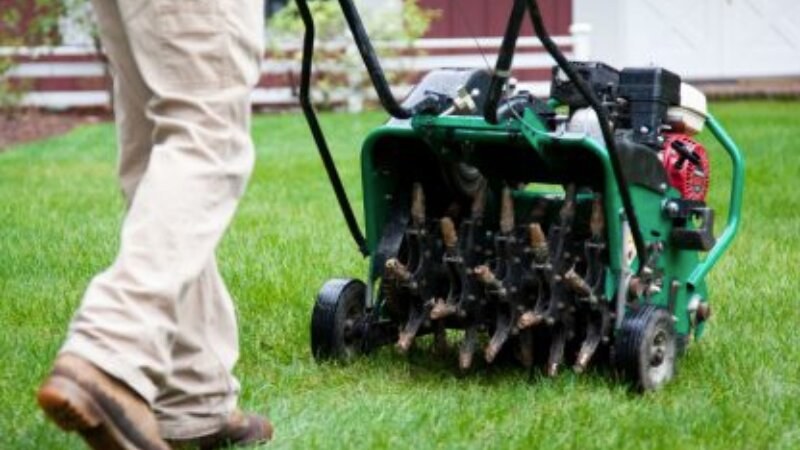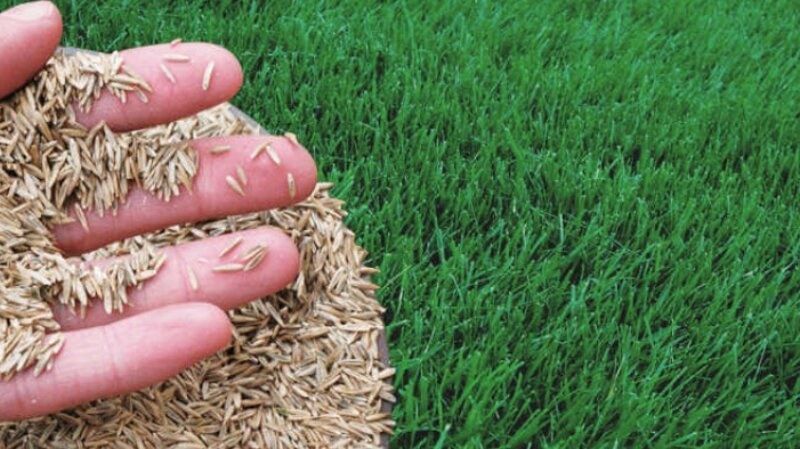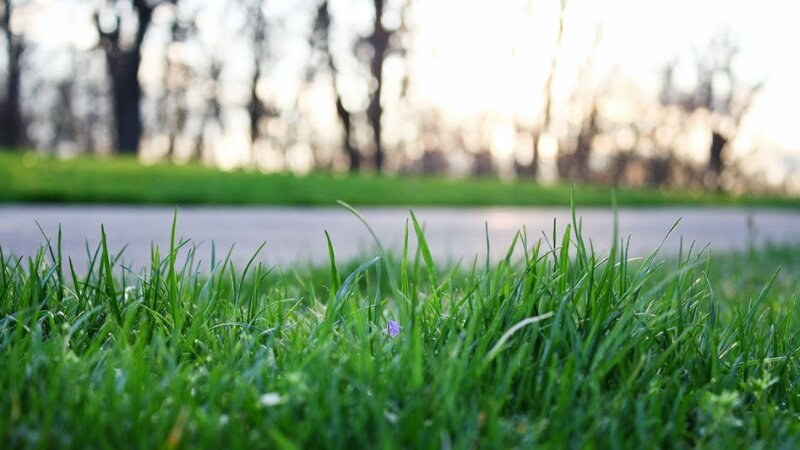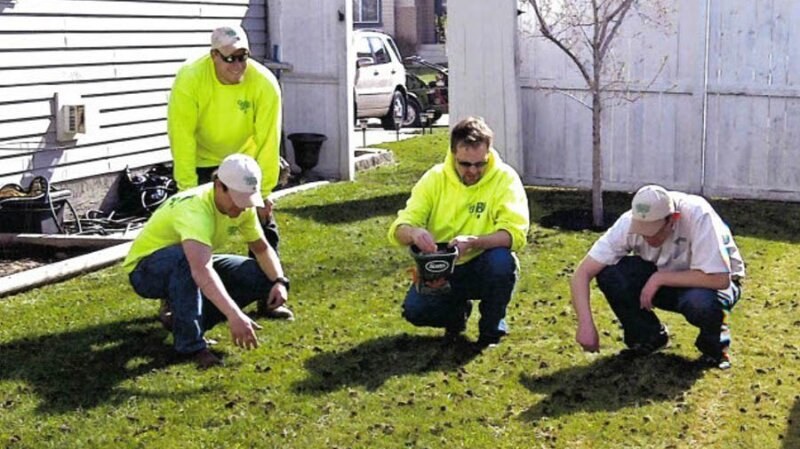The Difference Between Aeration and Overseeding & How It's Connected
Reading time: 6 minutesGetting a beautiful, healthy-looking lawn doesn't often come easy in Western Canada, especially with its cold winter weather. Employing some basic seasonal lawn care practices, like aeration and overseeding, goes a long way to achieving a layer of thick, green grass around your home.
As lawn experts, we know what it takes to keep your yard in great shape. Keep reading to learn about aeration and overseeding, their differences, and how they can be used together to create a knockout lawn all year.

What Is Lawn Aeration?
Aeration is the process of perforating or making tiny holes in your soil, either with a machine or a hand tool with spokes. This allows lawns to obtain better access to moisture, oxygen, and nutrients, which helps create strong, healthy-looking grass.
Aeration is crucial for promoting adequate drainage. If excess water is allowed to pool up on top of your grass after storms or watering your lawn, this can quickly lead to fungal diseases that put your whole lawn at risk.
What Is Overseeding?

Overseeding involves planting new grass seed directly into an existing lawn. It doesn't require the lawn or soil to be torn up and helps established lawns look thicker and greener. Over time, all lawns tend to become thin or bare-looking due to the growth cycle, even with regular care.
When patches of grass die naturally, it can cause your lawn to look bald or sick, even though nothing is wrong with it. Overseeding fills in these patches with new grass, creating a replenishment cycle. Turf that has been overseeded has greater resistance to foot traffic, summer drought, disease, pest infestations, and winter freeze.
How Aeration and Overseeding Work Together
Aeration and overseeding are almost always done in tandem, with aeration done first. This is because aeration helps prime the soil and makes it easier for grass seeds to sprout and root. Plus, overseeding discourages weed growth and offers better colour uniformity throughout your lawn.
In most cases, you’ll want to overseed no more than a few days after aerating. Usually, overseeding is done at the same time as aeration, taking advantage of the newly created top soil and dropping seeds into the fresh new pockets just created for them. With the proper lawn care techniques, most homeowners see drastic improvements in the colour, fullness, and quality of their grass in just a few weeks.
How to Know If Your Lawn Needs Aeration and Overseeding
Determining if you should aerate and overseed your lawn is relatively easy. You can either do it proactively once or twice a year in the spring and fall, or you can check your soil's compaction and moisture content by performing a “screwdriver test.”
To do this, take a screwdriver and try to push it down into your soil. If it's easy to slide down into the ground, compaction probably isn't an issue. When you take the screwdriver out, the soil shouldn't be wet or muddy, nor should it be too dry and crumbly.
If any of these issues are present during the screwdriver test, improving your lawn's access to oxygen and moisture can help.
Here are some other indications that it may be time to aerate your lawn:
You Have Clay Soil
Clay soils are more prone to compaction and should be regularly aerated to prevent this.
Your Lawn Gets Significant Foot Traffic
If you don’t have a walkway or people tend to walk on your lawn a lot, it’s likely compacted and needs aeration.
There’s Been Heavy Snow
In the winter, snow storms with a lot of accumulation can sit on your lawn for days, weeks, or even months with Canada’s brutally cold climate. This excess weight and moisture causes soil to become waterlogged and compacted and usually requires aeration in the spring after the snow season is over.
Your Home Was Recently Finished
New construction causes soil compaction as workers and equipment move across the ground around your home as it's being built.
Your Grass Is Sod
If you had sod put down instead of growing grass from seed, there may be soil layering. This is when the different layers of the soil inhibit moisture drainage, causing it to become waterlogged and compacted.
When to Aerate and Overseed Cool-Season Grasses

Cool-season grasses typically fare the best in Canada's chilly climate. This includes varieties like Canada and Kentucky bluegrasses, tall and fine fescues, and perennial ryegrass. These grasses grow the most during the spring and fall when the days are short and temperatures are cool. Growth slows dramatically during the summer and stops altogether in late fall to early winter when dormancy occurs.
Because of their temperature preferences, the best time to aerate and overseed cool-season grass varieties is in the spring & fall. Ideally, this is done either before or after the heat and humidity of summer have passed but well before the ground starts to freeze. This lets your lawn thicken and absorb as much moisture, nutrients, and oxygen as possible before dormancy.
You can also overseed with different grass varieties to give your lawn more texture, improve colour, and keep it even and level between seasons. But when doing this, make sure you’re using cool-season grasses suitable for cold climates. Avoid overseeding with warm-season grasses unlikely to perform well in Canada’s long, cold winters.
Read more about cool-season grass varieties in Western Canada here.
Frequently Asked Questions (FAQs) About Aeration and Overseeding
Should I wait to aerate after I apply an herbicide?
If you’ve recently applied weed control or herbicide to your lawn, you may have heard that aerating will “destroy” or interrupt the barrier. This isn’t true – you can aerate before or after applying weed deterrent without affecting the health of your grass.
What happens if I don’t aerate my lawn?
Without aeration—and overseeding—your lawn will eventually look thin, dried out, or diseased. This is because soil and grass naturally deteriorate over time and need to be refreshed so water and air can circulate again.
Can I fertilize my grass after I aerate?
You can fertilize your lawn right after you aerate, even if you’ve overseeded. Opt for a slow-release fertilizer to nourish established grass without harming baby grass blades that have yet to grow.
Do I have to mow after I aerate?
After aerating, you don’t have to mow your lawn to break the cores down. You can let this happen naturally over time, which could take a couple of weeks, depending on the size of the cores and the weather conditions.

Get a Healthy, Vibrant Lawn With Professional Aeration and Overseeding Services
The GreenKeepers at Green Drop know how to cultivate beautiful, lush-looking lawns in our cold climate. We can help you establish a customized lawn care plan that includes aeration and overseeding services, so you never have to worry about renting heavy equipment or getting your hands dirty.
Green Drop provides comprehensive lawn care services throughout Western Canada, including Calgary, Edmonton, Red Deer, Regina, Saskatoon, Winnipeg, and surrounding areas.

